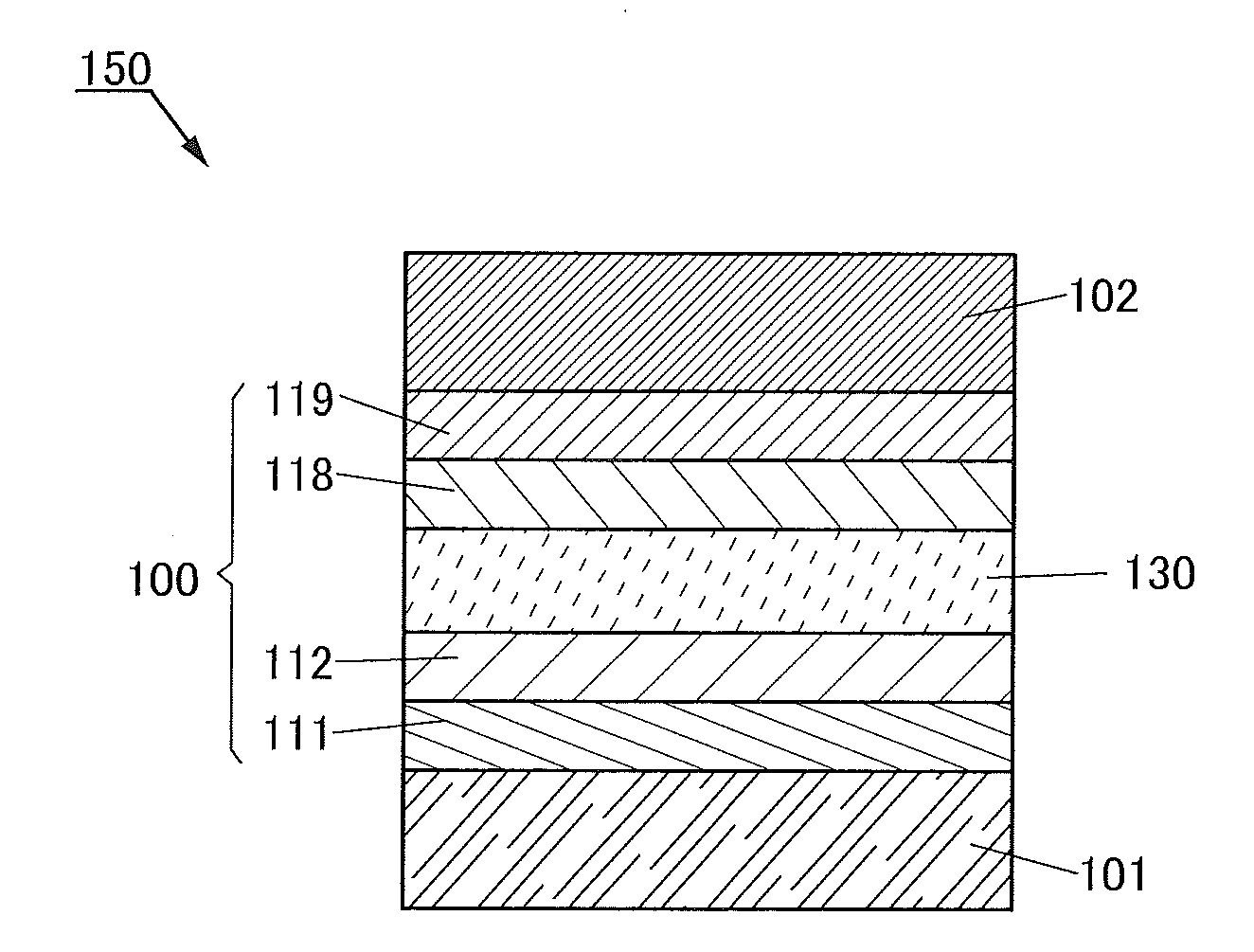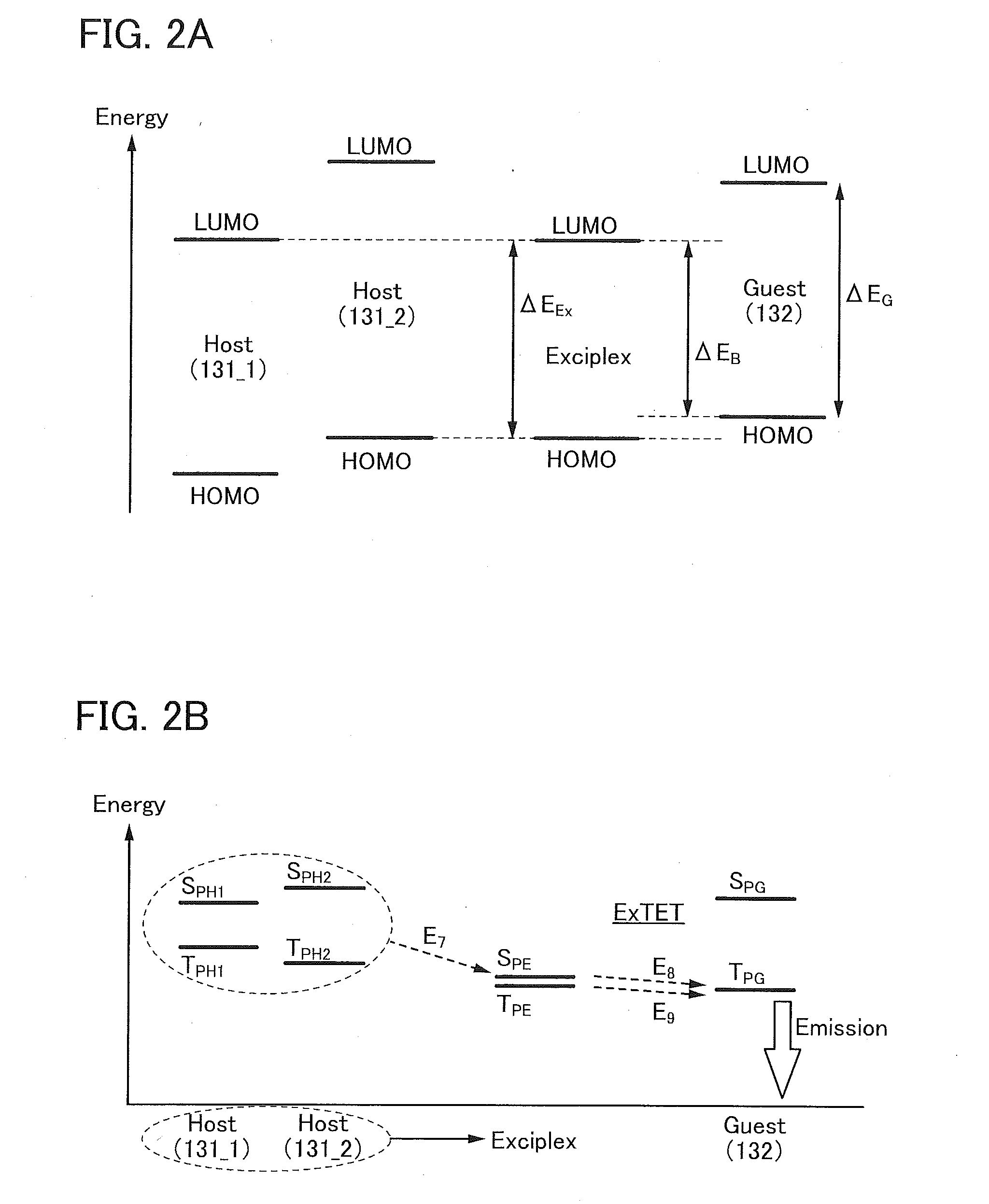Light-Emitting Element, Display Device, Electronic Device, and Lighting Device
a technology of light-emitting elements and electronic devices, which is applied in the direction of organic semiconductor devices, organic chemistry, indium organic compounds, etc., can solve the problems of poor electron-accepting properties, difficult excitation through direct recombination of carriers or efficient light emission by light-emitting elements in some cases, and achieve high emission efficiency, reduce power consumption, and high reliability
- Summary
- Abstract
- Description
- Claims
- Application Information
AI Technical Summary
Benefits of technology
Problems solved by technology
Method used
Image
Examples
embodiment 1
[0131]In this embodiment, a light-emitting element of one embodiment of the present invention will be described below with reference to FIGS. 1A and 1B and FIGS. 2A and 2B.
[0132]First, a structure of the light-emitting element of one embodiment of the present invention will be described with reference to FIGS. 1A and 1B.
[0133]FIG. 1A is a schematic cross-sectional view of a light-emitting element 150 of one embodiment of the present invention.
[0134]The light-emitting element 150 includes a pair of electrodes (an electrode 101 and an electrode 102) and an EL layer 100 between the pair of electrodes. The EL layer 100 includes at least a light-emitting layer 130.
[0135]The EL layer 100 illustrated in FIG. 1A includes functional layers such as a hole-injection layer 111, a hole-transport layer 112, an electron-transport layer 118, and an electron-injection layer 119, in addition to the light-emitting layer 130.
[0136]In this embodiment, although description is given assuming that the elec...
embodiment 2
[0311]In this embodiment, light-emitting elements each having a structure different from that described in Embodiment 1 are described below with reference to FIGS. 3A to 3C and FIGS. 4A to 4C. In FIGS. 3A to 3C and FIGS. 4A to 4C, a portion having a function similar to that in FIG. 1A is represented by the same hatch pattern as in FIG. 1A and not especially denoted by a reference numeral in some cases. In addition, common reference numerals are used for portions having similar functions, and a detailed description of the portions is omitted in some cases.
[0312]FIG. 3A is a schematic cross-sectional view of a light-emitting element 250.
[0313]The light-emitting element 250 illustrated in FIG. 3A includes a plurality of light-emitting units (a light-emitting unit 106 and a light-emitting unit 108 in FIG. 3A) between a pair of electrodes (the electrode 101 and the electrode 102). One of light-emitting units preferably has the same structure as the EL layer 100 illustrated in FIGS. 1A an...
embodiment 3
[0395]In this embodiment, examples of light-emitting elements having structures different from those described in Embodiments 1 and 2 are described below with reference to FIGS. 5A and 5B, FIGS. 6A and 6B, FIGS. 7A to 7C, and FIGS. 8A to 8C.
[0396]FIGS. 5A and 5B are cross-sectional views each illustrating a light-emitting element of one embodiment of the present invention. In FIGS. 5A and 5B, a portion having a function similar to that in FIG. 1A is represented by the same hatch pattern as in FIG. 1A and not especially denoted by a reference numeral in some cases. In addition, common reference numerals are used for portions having similar functions, and a detailed description of the portions is omitted in some cases.
[0397]Light-emitting elements 260a and 260b in FIGS. 5A and 5B may have a bottom-emission structure in which light is extracted through the substrate 200 or may have a top-emission structure in which light emitted from the light-emitting element is extracted in the direc...
PUM
| Property | Measurement | Unit |
|---|---|---|
| transition energy | aaaaa | aaaaa |
| light emission energy | aaaaa | aaaaa |
| temperature | aaaaa | aaaaa |
Abstract
Description
Claims
Application Information
 Login to View More
Login to View More - R&D
- Intellectual Property
- Life Sciences
- Materials
- Tech Scout
- Unparalleled Data Quality
- Higher Quality Content
- 60% Fewer Hallucinations
Browse by: Latest US Patents, China's latest patents, Technical Efficacy Thesaurus, Application Domain, Technology Topic, Popular Technical Reports.
© 2025 PatSnap. All rights reserved.Legal|Privacy policy|Modern Slavery Act Transparency Statement|Sitemap|About US| Contact US: help@patsnap.com



